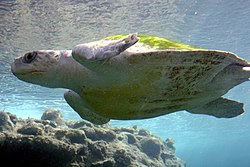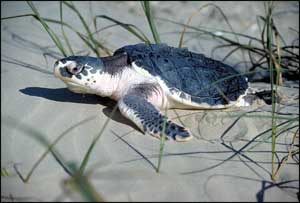What is Happening?
Population Problems
In the 1940s, there were about 100,000 nesting female Kemp's Ridleys
that came to shore in a single day. By the 1980s, however, there were
around a few hundred.
There have been conservation efforts between the US and Mexico
since the 1970s, when the beach Rancho Nuevo was declared a National
Reserve. Those efforts are working very well and today there is an estimated
female breeding population of between 1,000 to 10,000 individual Kemp's Ridleys.

Main Threats
Kemp's Ridley sea turtles have many threats, like other species of turtles.
One of their main threats is water pollution. Water pollution is generally
caused by oil spills and sewage that has been thrown into the waters.
Another threat is poor fishing practices. These practices include fishing
in the habitats of vulnerable species and poison fishing (fishing
where you use a poison to stun fish).
Some other main threats to the Kemp's Ridley are...
- Habitat loss
- Climate change
- Meat and egg collection for consumption
- Wildlife trade
- Capture (incidental)
Predators
Kemps' Ridley sea turtles have few predators, but that doesn't mean they have
none. Sea turtle hatchlings have to be careful when crawling to
open waters. Ghost crabs, sea gulls, and other sea birds.
Kemp's Ridleys protect themselves with their hard shells, but
their excellent swimming helps them escape from predators in
the water.


SOURCES


